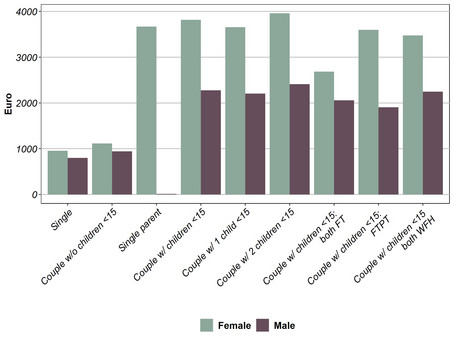#8 Blog: The value of our work – unpaid housework and care work during the lockdown
(this text was first published in German under: https://www.diepresse.com/5873746/wir-sollten-unbezahlte-arbeit-sichtbar-machen)
The consequences of the COVID-19 crisis are far reaching: from the highest unemployment rates in decades to struggles for financial survival and health concerns. Other immediate impacts, such as the overburden of parents during the lockdown are generally less discussed.
The stay-at-home orders enormously increased the unpaid work, such as housework and child care. Many activities and services have been relocated into the private sphere. Services previously provided by institutions, such as kindergartens and schools, support from grandparents or - provided sufficient income - paid services, such as cleaning staff or babysitting, were unavailable. Respondents stated that days did not have 24 but rather 36 to 42 hours, which highlights the overburden and stress. Further strains were expressed through the feeling of doing “everything alone”, in particular from mothers of school-age children.
In German-speaking countries, these multiple burdens sparked protests on social media under the hashtag #coronaeltern. Exhausted parents organized, demanding transparency, plans and information about upcoming openings of kindergartens and schools. In Germany, mothers listed all the work they did simultaneously during the lockdown and wrote invoices for them under the hashtag #coronaelternrechnerab.
Similar approaches are used in social sciences to make unpaid work, its volume and necessity as an input for the entire economy, visible.
Based on the last official Austrian time use study from 2008/09, the annual unpaid work of nine billion of hours in related industries would bring earnings of 100 to 105 billion EUR. In 2008/09 this was between 27 and 35% of GDP, depending on the estimate.
Consequently, this leads us to the question of how much could have been earned by people living in Austria during workdays of the lockdown if unpaid work were to be paid.
We estimate the value of unpaid work based on our time use survey that we carried out at the beginning of May 2020. During the seven-week lockdown, women in our sample took on an average of 210 hours of unpaid work and men 145 hours. A single mother did 320 hours of unpaid work. A mother of 2, living in a couple household, spent an average of 340 hours doing unpaid work, while her partner did 205 hours. In a household with children under 15, where both parents worked from home, her unpaid work during lockdown amounted to just under 300 hours and his to 193 hours. For comparison, a single female worked 99 hours and a single male 84 hours unpaid. Women generally did between 15 and 89% more unpaid work than men. The difference was particularly clear in couple households with children under 15 years of age.
We can make use of these time use estimates and value the unpaid work with the corresponding wage rates. This is only the first step to compute the overall household production. Other input, such as capital, taxes and intermediary consumptions are not considered here.
There are three prominent approaches on valuing unpaid work: a generalist, a specialist and an opportunity cost approach. For the generalist approach, a wage rate is chosen that an employee would receive for all housework duties, such as a housekeeper. A more nuanced approach is the specialist approach, which divides unpaid work into different tasks. For each task, the wage rate of someone who is hired to do such tasks is used (e.g. cooking - wage of a cook). For our estimates, we use the minimum wage rates in collective agreements in related professions. For example, a cook has a collectively agreed minimum hourly wage of EUR 9.54, a kindergarten teacher EUR 13.58, a gardener EUR 11.51, a tutor of EUR 11.16, etc.
The above-mentioned mother of two children under 15, living in a couple household, cooked 55 hours during the lockdown, cleaned 47 hours and took on other household chores such as gardening or animal care for almost 16 hours. She spent 77 hours providing basic care for her children, 48 hours studying with the children and 97 hours doing leisure time activities with the children. According to the specialist approach, this would correspond to a value of around 3.860 EUR. The unpaid work of a related father would have been worth 2.410 EUR during the lockdown. In comparison, a female single without children has taken on work worth 960 EUR, a male one worth EUR 800.
Figure 1: Value of unpaid work during the 7-week lockdown by household type

Notes: FT… full time employment, PT… part time employment, WFH… working from home
The generalist and specialist approach both assume how much a household saves if certain work is done by themselves and not bought in on the market. The opportunity cost approach, which #coronaelternrechnerab essentially used, focuses on the income that household members miss when they spend the time on household chores instead of working on the labour market. The wage rate chosen is therefore the rate that people, who perform unpaid work, would receive in the labour market according to their qualifications, experience, and sector. This approach leads to significantly higher monetary valuations, but also to the fact that – due to the gender pay gap – unpaid work by women and men is not valued equally.
Regardless of the type of calculation, the amount of unpaid work performed in households during the lockdown – both in terms of time units and in monetary terms – was substantial. Women took on most of this work. Even if the value of unpaid work can be approximated in monetary terms, unpaid work and paid work are not necessarily completely substitutable. It is of great importance to make unpaid work more visible, especially when we must raise the questions of how parents and in particular mothers, are able to cope with a second lockdown and/or school closures.
